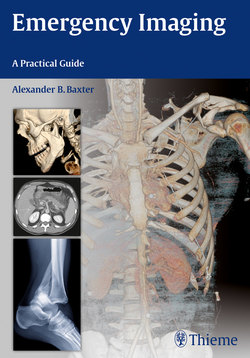Читать книгу Emergency Imaging - Alexander B. Baxter - Страница 19
На сайте Литреса книга снята с продажи.
Оглавление4Emergency Imaging
some patients are at increased risk for ad-verse, allergic-like reactions to contrast material. Such reactions range from mild to life-threatening; they can be mitigated by premedication, which reduces the inci-dence and severity of mild and moderate reactions and theoretically reduces the in-cidence of severe ones. The following dis-cussion and recommendations are based on the New York University Medical Center and Bellevue Hospital Radiology Depart-ment practice policies.
0 and a window of ~ 4,000. In this case, all 4,000 densities are distributed over ~ 700 distinguishable shades of gray. Soft tis-sues have densities between – 100 and 300, so their densities will be mapped to a relatively small number of gray tones in the middle of the window and will be in-distinguishable from each other. The vari-ous densities of bone (cortical bone, bone marrow, trabeculae) are distributed over a much larger number of HU, so they will be visible in detail.
To optimally study the subtle dier-ences in densities of the brain, on the other hand, one can a set a level of 30, the den-sity of the brain in HU, and a window of 80, a relatively narrow setting. In this case, only 160 densities are distributed over the visible range, permitting visualization of blood, scalp, white matter, gray matter, and cerebrospinal fluid (CSF). With narrow windows, bone detail is limited, and all bone elements appear white. With these settings fat (– 70) and air (– 1,000) are also both outside of the window margins and will appear black. Widening the window to 150 would increase the visibility of fat as distinct from air (Fig. 1.1).
◆ Approximate Radiation Doses for Emergency Studies (mSv)
It is useful to have a sense of the relative radiation doses for common examinations, in comparison to natural background ra-diation, which is approximately 3–4 mil-lisieverts (mSv) per year. Radiation doses above 10 mSv are associated with increased risk of cancer, with a 5% increased cancer risk at doses above 1,000 mSv (Table 1.2).
◆ CT Contrast Administration, Risks, and Adverse Reactions
Contrast material for CT examinations is administered via intravenous (IV) cath-eter. Rapid administration for arterial and venous visualization (as in pulmonary embolism, mesenteric ischemia, aortic dissection) generally requires a well-func-tioning, large-gauge peripheral catheter or central introducer sheath. In addition,
Table 1.2 Approximate radiation doses for emergency studies
Whole body dosesmSv
Dental X-ray
0.005
Background radiation, 1 day0.01
Flight across United States0.04
Chest X-ray
0.2
Mammogram
0.4
Extremity (per view)
0.5
Pelvis
0.7
Hip
0.8
Abdomen radiograph
1.2
Head CT
2
Ventilation/perfusion scan2
Lumbar spine radiographs3.5
Background radiation, 1 year4
Conventional coronary angiography5
Chest CT8
Abdomen CT
10
Pelvis CT
10
Coronary CT angiography15
Yearly maximum for radiation workers50
Fetal doses with shielding (unless fetus is in eld of view)
Chest X-ray< 0.01
Abdomen radiograph
2.4
Pelvis
1.7
Lumbar spine
3.4
Head CT
< 1
Chest CT
< 1
Abdomen CT
10
Pelvis CT
10
